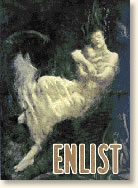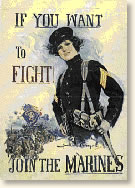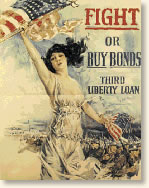Posters at War
All the participants in World War I used posters to mold public opinion. The
best of these had certain traits in common - simplicity
 |
"Enlist", a poster
issued shortly after the
sinking of the Luisitania |
of message and the ability
to stir the emotions. Their immediate goals were varied - to raise money, to
conserve food or resources, to promote enlistment or to instill patriotic fervor,
to name a few. Placed at railway stations, bus stops, theaters, schools or any
place that people may gather, their message could not be ignored.
The poster campaign in the United States actually began before America entered the war. Germany's unrestricted submarine warfare and the sinking of the Lusitania brought pressure on Congress and President Wilson to increase America's "preparedness" for war. Evoking memories of the Lusitania tragedy and challenging young men to "prepare" for their country, the campaign was successful. In the summer of 1915, the War
 |
Recruiting poster used
during the "preparedness"
campaign, 1915 |
Department opened a training camp at Plattsburgh, NY where Regular Army officers operated a Boot Camp for the sons of well-to-do businessmen. The expenses of the camp where paid for by the trainees.
Within days after Congress declared war against Germany in April 1917, Charles Dana Gibson (creator of the "Gibson Girl") gathered a group of artists who pledged their talents to the promotion of the war effort. The organization was soon absorbed into the Committee on Public Information set up by President Wilson under the title of the Division of Pictorial Publicity. Extending from coast to coast, the Division of Pictorial Publicity enlisted the cream of the crop of artistic talent in the United States: N.C. Wyeth, Howard Chandler Christy, James Montgomery Flagg and a young Norman Rockwell among them. The organization eventually included over 300 artists, all volunteers and all unpaid. By war's end the organization submitted seven hundred poster designs to the U.S.
 |
Poster for the
3rd Liberty Loan
Drive, 1918 |
government resulting in the printing of hundreds of thousands of posters.
The artists' immediate task of whipping up enthusiasm for the war was made difficult by Wilson's victory in the election of 1916. Wilson won on a campaign slogan of "He kept us out of war." Wilson's margin of victory was close, so close that it took three days before the election results were finalized. In the end he won by only twenty-three electoral votes. The anti-war movement was strong in the country and constituted much of Wilson's political support. A good deal of the early propaganda effort was therefore devoted to explaining why the country must fight.
References:
Pitz, Henry, 200 Years of American Illustration (1977); Rawls, Walton, Wake Up America, World War I and The American Poster (1988).
How To Cite This Article:
"Posters at War," EyeWitness to History, www.eyewitnesstohistory.com (2000).
|






